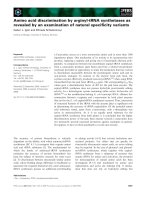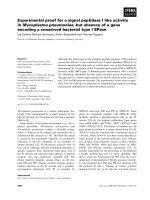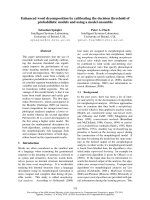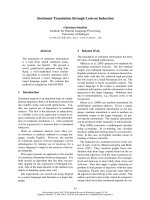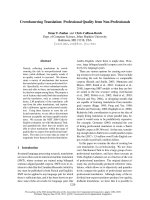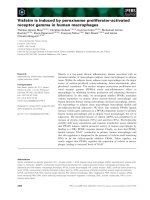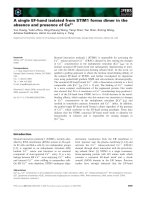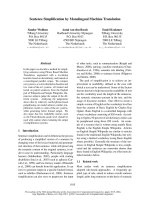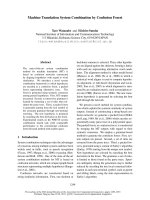Báo cáo khoa học: Abortive translation caused by peptidyl-tRNA drop-off at NGG codons in the early coding region of mRNA potx
Bạn đang xem bản rút gọn của tài liệu. Xem và tải ngay bản đầy đủ của tài liệu tại đây (572.89 KB, 11 trang )
Abortive translation caused by peptidyl-tRNA drop-off
at NGG codons in the early coding region of mRNA
Ernesto I. Gonzalez de Valdivia and Leif A. Isaksson
Department of Genetics, Microbiology and Toxicology, Stockholm University, Sweden
As an early step during translation initiation in bac-
teria the mRNA is anchored to the 30S ribosomal sub-
unit by base pairing between a sequence close to the
end of the 16S ribosomal RNA and the Shine–Dal-
garno (SD) sequence, a few bases upstream of the initi-
ation codon in the mRNA. Even though the SD
sequence increases initiation efficiency, mRNAs that
lack this sequence can be translated [1] albeit at a
lower efficiency [2]. In such case the sequence in the
downstream region (DR) immediately following the
initiation codon has a large influence on gene expres-
sion at the translation level [3]. This effect was origin-
ally suggested to be the result of an additional
anchoring by base pairing between the DR sequence in
mRNA and 16S rRNA but this model has been refu-
ted experimentally [4,5]. Many rare codons are used
within the first 25 codons in Escherichia coli [6].
Clearly, the early coding region in mRNA is important
for gene expression, presumably at the translational
level.
A closer study of the DR region has revealed that
the nature of the +2 codon can affect expression by
up to a factor of 20. A number of codons, but in par-
ticular G-rich codons, at this position give low gene
expression. The codons that follow in the DR have rel-
atively similar effects giving normal gene expression
with the notable exception of NGG codons (AGG,
CGG, UGG and GGG) as these lower gene expression
down to 10–20% also if located at positions +3 to
+5. The other G-rich codons GGN and GNG (where
N is non-G) do not have this effect in this sequence
window. At position +7 all G-rich codons, including
NGG give normal expression. This is also the case if
they are placed at +11 [3,7–10]. The reduced level of
gene expression that is seen for the NGG codons in
the early coding region is not the result of lowered
Keywords
abortive translation; NGG codons; peptidyl-
tRNA drop-off; Escherichia coli; early
elongation
Correspondence
L. A. Isaksson, Department of Genetics,
Microbiology and Toxicology, Stockholm
University, S-106 91 Stockholm, Sweden
Fax: +46 8 15 51 39
Tel: +46 8 16 41 97
E-mail:
Website:
(Received 29 June 2005, revised 17 August
2005, accepted 19 August 2005)
doi:10.1111/j.1742-4658.2005.04926.x
In Escherichia coli the codons CGG, AGG, UGG or GGG (NGG codons)
but not GGN or GNG (where N is non-G) are associated with low expres-
sion of a reporter gene, if located at positions +2 to +5. Induction of a
lacZ reporter gene with any one of the NGG codons at position +2 to
+5 does not influence growth of a normal strain, but growth of a strain
with a defective peptidyl-tRNA hydrolase (Pth) enzyme is inhibited. The
same codons, if placed at position +7, did not give this effect. Other
codons, such as CGU and AGA, at location +2 to +5, did not give any
growth inhibition of either the wild-type or the mutant strain. The inhibi-
tory effect on the pth mutant strain by NGG codons at location +5 was
suppressed by overexpression of the Pth enzyme from a plasmid. However,
the overexpression of cognate tRNAs for AGG or GGG did not rescue
from the growth inhibition associated with these codons early in the
induced model gene. The data suggest that the NGG codons trigger pep-
tidyl-tRNA drop-off if located at early coding positions in mRNA, thereby
strongly reducing gene expression. This does not happen if these codons
are located further down in the mRNA at position +7, or later.
Abbreviations
SD, Shine–Dalgarno; DR, downstream region; Pth, peptidyl-tRNA hydrolase; IPTG, isopropyl thio-b-
D-galactoside; Ts, temperature sensitive.
5306 FEBS Journal 272 (2005) 5306–5316 ª 2005 FEBS
mRNA levels or secondary structure formation.
Rather, some abortive event seems likely. One possibil-
ity would be shifting of the translational reading frame
giving premature termination at some out-of-phase ter-
mination codon. However, this explanation does not
seem to be valid. Another possibility would be drop-
off of peptidyl-tRNA from the translating ribosome
during early elongation [11]. In this case the released
peptidyl-tRNA would be cleaved by the peptidyl-
tRNA hydrolase (Pth) [12], thereby initiating turnover
and re-use of the amino acid residues and the tRNA
moiety.
A mutant E. coli strain is available that has a heat
sensitive Pth. At high temperature this mutant does not
grow because the accumulated peptidyl-tRNA cannot
be degraded [13]. This will give shortage of tRNA as a
consequence, which is likely to be one of the reasons
for the heat-sensitive phenotype of the mutant [14].
Increased heat sensitivity of the pth mutant strain
has been used to demonstrate accumulation of pep-
tidyl-tRNA in connection with overexpression of short
mini-genes [15–18]. Drop-off at a pair of rare AGA
AGG codons has been demonstrated in a natural gene
and ribosome stalling and drop-off at a pair of argin-
ine codons in mini-genes [19].
In the present study we show that the NGG codons
CGG, AGG, GGG and UGG, when they are posi-
tioned in the early coding region downstream of the
initiation codon in a highly expressed reporter gene,
inhibit growth of a pth thermo-sensitive (Ts) mutant
strain. This effect is not seen for other codons or for
the NGG codons if placed at a later position (+7).
The results suggest that low gene expression associated
with NGG in early coding reading in mRNA is the
result of peptidyl-tRNA drop-off from the ribosome
during translation in E. coli.
Results
Induction of a test gene with an early NGG
codon inhibits growth of a pth(Ts) strain
Codons at position +2, immediately following the
AUG initiation codon, influence gene expression by up
to a factor of 20. Further down at positions +3 to
+5 in the DR this codon influence is less pronounced
with the notable exception of the NGG codons that
lower gene expression to only 10–20% [10]. The other
G-rich codons GGN and GNG (where N is non-G),
do not give such low gene expression. The low expres-
sion associated with NGG is not seen if the codon is
located further down in the mRNA coding region at
+7 [10].
One possible reason for the low gene expression
caused by the early NGG codons could be abortive
translation as a result of peptidyl-tRNA drop-off at
these codons [13]. Such released peptidyl-tRNA is nor-
mally hydrolysed by a Pth, thus allowing recycling of
both the amino acids and the tRNA. A mutant strain
MB01 is available with a pth(Ts) (Table 1). In this
mutant strain accumulation of peptidyl-tRNA, that
cannot be degraded and recycled, leads to inability to
grow at high temperature [14]. Introduction of plasmid
pVH1 with its pth
+
gene gives partial complementa-
tion of the temperature sensitivity of MB01 (Table 2).
This complementation is not complete, probably
because of the low copy number of pVH1 [20].
Table 1. Bacterial strains and plasmids.
Relevant characteristics References
Strains
MC1061 araD139, D(lacI POZYl) 74, galU,
galK, rpsL, D(ara A BC-leu)7697, hsdR,
mcrB,Sm
S
,
[44]
XAC D(lacproB), arg E, ara, gyrA, rpoB, thi [43]
MG1655 Wild-type [21]
MB01 MG1655, zdh-925::Tn10, pth(Ts) This work
Plasmids
lacZ
pCMS71 Derivative of pCM21 with cloning
cassette, Amp
R
[9,10]
Protein A¢
pHN109 Derivative of pAB93 with
an internal 2A¢
[30]
Control gene and cloning cassette,
Amp
R
pEG998 Derivative of pHN109 with Csp45I
restriction site
[10]
Others
pUBS250 arg U
+
(tRNA
Arg4
), Kan
R
[34]
pArgUW argU
+
(tRNA
Arg4
), argW
+
(tRNA
Arg5
)Kan
R
[40]
pVH1 pth
+
,Kan
R
[20]
pJMM19 lysV
+
(tRNA
Lys
), Kan
R
[20]
pMO22 glyU
+
(tRNA
Gly1
), Tet
R
[39]
Table 2. Effect of temperature on growth of strain MB01 with a
heat sensitive peptidyl-tRNA hydrolase. Strains were streaked on
Luria–Bertani agar plates with IPTG (1 m
M) (+) or without (–), and
incubated at the indicated temperatures.
Strains Plasmid
IPTG (–) IPTG (+)
30 °C 37.5 °C43°C30°C 37.5 °C43°C
MG1655 – ++++ ++++ ++++ ++++ ++++ ++++
MB01 – ++++ +++ – ++++ +++ –
MB01 pVH1 ++++ ++++ – ⁄ + ++++ ++++ +
E. I. Gonzalez de Valdivia and L. A. Isaksson Abortive translation due to drop-off at NGG codons
FEBS Journal 272 (2005) 5306–5316 ª 2005 FEBS 5307
To test for excessive drop-off of peptidyl-tRNA at
certain early codons (including the NGG codons) they
were placed in the 5¢-coding region of a lacZ reporter
gene in a plasmid (Fig. 1A) and introduced into the
pth(Ts) mutant strain MB01, with its temperature sen-
sitive Pth (Table 1). Cultures were pregrown at 30 °C,
followed by dilution into the same medium with or
without isopropyl thio-b-d-galactoside (IPTG; 1 mm)
whereafter growth was continued at 37.5 °C. As shown
in Fig. 1, induction of test genes with NGG codons at
positions +2, +3 and +5 inhibits growth of the
pth(Ts) strain. This inhibitory effect is not obtained if
the NGG codons are located at +7 or if the test gene
is not induced by IPTG. It was noted, but not ana-
lysed further, that cells with the nondrop-off codons
CGU and AGA at position +7 were delayed in
growth in the early growth phase. The arginine codons
CGU and AGA at +2, +3 and +5 did not inhibit
growth of the strain even in the presence of IPTG
induction. All of these results suggest that the low gene
expression associated with NGG codons in the down-
stream region following the initiation codon [9,10], is
the result of peptidyl-tRNA drop-off that is excessive
enough to inhibit growth of a pth(Ts) mutant strain.
Pth enzyme rescues from growth inhibition by
+5 NGG codons
As described above, it appeared likely that the inhibi-
tory growth effect by early NGG codons in the pth(Ts)
mutant MB01 was due to accumulation of peptidyl-
tRNA, as the result of an abortive drop-off event.
MB01 did not grow at 43 °C and it showed disturbed
growth at 37.5 °C (Table 2). To confirm that the
A B
Fig. 1 Plasmid constructs are derivatives of pDA3480 [9,10]. The 5¢ end of the transcript is 5¢-AAUUGUGAGCGGAUAACAAUUUCA-
CCAGGUAAUAAAUU
AAAUAAAAUUUAAAUAUG-3¢ for the gene variants that lack a functional Shine–Dalgarno sequence (SD, underlined)
[21]. (A) LacZ reporter gene construct pCMS71 was used as a cloning vector for the insertion of different AUG downstream context
sequences using the restriction sites SwaI ⁄ SalIandSwaI ⁄ Csp45I. The lacZ gene is under control of the trc promoter [9]. (B) Protein A¢
reporter gene construct pEG998, earlier denoted pEG1000 [10], was used as cloning vector to subclone different AUG downstream
context sequences using the restriction sites SwaI ⁄ SalI and SwaI ⁄ Csp45I.
Abortive translation due to drop-off at NGG codons E. I. Gonzalez de Valdivia and L. A. Isaksson
5308 FEBS Journal 272 (2005) 5306–5316 ª 2005 FEBS
disturbed growth was the result of peptidyl-tRNA
accumulation a plasmid (pVH1) containing the pth
+
gene was introduced into the pth(Ts) strain, harbour-
ing another compatible plasmid that carries the lacZ
reporter gene with AGG or GGG at position +5.
Transformants were streaked on broth plates, with or
without 1 mm IPTG, and incubated at 30 °Cor
37.5 °C. In the absence of a pth
+
carrying plasmid,
without IPTG induction, growth of the lacZ variant
with AGG or GGG at position +5 was disturbed at
37.5 °C (Table 3). In the presence of IPTG growth
inhibition was more severe. Co-expression of the plas-
mid pVH1 with its pth
+
and the plasmid with the test
gene with +5 AGG or GGG protected from the
inhibitory effect by these codons at 37.5 °C, even in
the presence of IPTG. LacZ variants with CGG or
UGG at +5 gave similar growth inhibition as AGG
and GGG (not shown). These results strongly suggest
that growth inhibition by +5 NGG codons at 37.5 °C
is the result of accumulation of peptidyl-tRNA, caused
by drop-off from the ribosome during translation, and
low activity of Pth in the MB01 mutant strain. Fur-
thermore, no codons, including NGG, inhibited
growth of the MB01 strain if placed at +7 (Fig. 1D)
even in the presence of IPTG. Also these results are
consistent with an earlier report that there is little
influence of +7 codons on gene expression [10,21].
The data presented here suggest that NGG codons at
early coding positions cause growth inhibition of a
pth(Ts) mutant strain as a result of peptidyl-tRNA
drop-off and insufficient Pth activity.
Gene expression values in a normal pth
+
strain, in
the absence of IPTG induction, are presented as inserts
in Fig. 1. These values confirm the previous findings of
low gene expression being associated with early NGG
codons [10,21]. They also demonstrate the correlation
between a negative effect on gene expression and a
strong negative effect on growth of a pth
–
mutant
strain.
Overexpression of tRNA has no effect on gene
expression or growth inhibition associated with
early NGG codons
The MB01 mutant strain is supposed to be growth
inhibited at 37.5 °C because of accumulation of pep-
tidyl-tRNA, thus possibly causing decreased turnover
and starvation for the tRNA moiety [22]. One would
therefore expect that overexpression of the correspond-
ing tRNA would protect from growth inhibition at
37.5 °C by the +5 NGG codons, in a similar manner
as does introduction of a plasmid encoding the pth
+
gene. To test for this possibility a plasmid with +5
AGG in the test gene was combined in the MB01
strain with the plasmid pUBS520 that carries the
tRNA
Arg4
gene, or plasmid pArgUW with the
tRNA
Arg4
(decodes AGA and AGG) and tRNA
Arg5
(decodes only AGG) genes. A plasmid with a +5
GGG construct was combined with the plasmid
pMO22 that carries the gene for the cognate tRNA
Gly1
(decodes only GGG).
Plasmid carrying cells with the different variants of
+5 NGG codons were analysed in a similar test as
described above for the pth
+
plasmid. However, unlike
the pth
+
carrying plasmid pVH1, the plasmid
pUBS520 (encoding tRNA
Arg4
), pArgUW (encoding
tRNA
Arg4
and tRNA
Arg5
) or plasmid pMO22 (enco-
ding tRNA
Gly1
) did not protect cells from the negative
effect by the induced test gene, with its +5 NGG
codon AGG or GGG, respectively (Table 3). It was
Table 3. Complementation of growth inhibition of MB01 by overexpressed genes. Plasmids and strains MG16555 or MB01 are described in
Table 1. The strains were streaked on Luria–Bertani agar plates with IPTG (1 m
M) (+) or without (–), and incubated at 37.5 °C.
Plasmids Features
IPTG
–+
MG1655 MB01 MG1655 MB01
– – ++++ +++ ++++ +++
pUBS250 tRNA
Arg4
++++ +++ ++++ – ⁄ +
pArgUW tRNA
Arg4; 5
++++ +++ ++++ – ⁄ +
pMO22 tRNA
Gly 1
++++ +++ ++++ +++
pEG216 AGG +5 ++++ +++ ++++ – ⁄ +
pEG216 ⁄ pVH1 AGG +5 ⁄ pth
+
++++ ++++ ++++ ++++
pEG216 ⁄ pUBS250 AGG +5 ⁄ tRNA
Arg4
++++ +++ ++++ – ⁄ +
pEG216 ⁄ pArgUW AGG +5 ⁄ tRNA
Arg4; 5
++++ +++ ++++ – ⁄ +
pEG207 GGG +5 ++++ +++ ++++ – ⁄ +
pEG207 ⁄ pVH1 GGG +5 ⁄ pth
+
++++ ++++ ++++ ++++
pEG207 ⁄ pMO22 GGG +5 ⁄ tRNA
Gly1
++++ +++ ++++ – ⁄ +
E. I. Gonzalez de Valdivia and L. A. Isaksson Abortive translation due to drop-off at NGG codons
FEBS Journal 272 (2005) 5306–5316 ª 2005 FEBS 5309
noted that the plasmids encoding tRNA
Arg4
or
tRNA
Arg4
and tRNA
Arg5
were toxic for the MB01
mutant strain, but not for the wild-type strain, even in
the absence of the lacZ variant with its +5 AGG
codon. On the contrary, the plasmid that carries the
tRNA
Gly1
gene did not alone influence growth of the
MB01 mutant strain, nor did it suppress the low gene
expression associated with +5 GGG.
The effect on gene expression by an increased intra-
cellular pool of relevant tRNAs was analysed. For this
purpose the A¢ reporter system was used (formally
referred to as Z-protein) Fig. 2B. This reporter system
is carried by a plasmid with the 3A¢ and 2A¢ genes
[10]. Both are based on a gene which codes for three
or two, respectively, identical engineered antibody
binding B-domains of protein A from Staphylococcus
aureus. Both genes are under separate control of iden-
tical Ptrc promoters and Ttrp terminators. The 3A¢
test gene is used to analyse the effects on expression
by base alterations whereas the 2A¢ is kept constant as
an internal control. The protein products can be affin-
ity purified in a single step using an IgG–Sepharose
column. Gene expression can be estimated by separ-
ation of the two A¢ proteins on gel electrophoresis.
Scanning of the protein bands give the relative gene
expression (3A¢⁄2A¢ ratio).
The question was asked if excess tRNA cognate
to the codon preceding an NGG codon has any
influence on the low gene expression associated with
such codons. The lysine codon AAA, that gives high
gene expression if located at position +2, was cho-
sen. Plasmid constructs with AAA at +2 and either
one of the NGG codons at +3 (Fig. 2B) were coex-
pressed in strain XAC together with another plasmid
(pJMM19) encoding tRNA
Lys
. The transformants
with their two compatible plasmids were grown
under appropriate double antibiotic selection pressure
and the 3A¢ and 2A¢ protein products were isolated
and quantified by SDS ⁄ PAGE. Figure 3A shows that
tRNA
Lys
overexpression, being cognate to the +2
AAA, did not significantly suppress the low expres-
sion caused by the +3 NGG codons in the 3A¢ test
gene.
The question was also asked if excess tRNA, cog-
nate to an early NGG codon, influences gene expres-
sion. For this purpose, 3A¢ encoding plasmids with
+2, +3, +4, +5 or +7 AGG, GGG or AGA were
combined with plasmid pUBS250 (encoding tRNA
Arg4
)
or pArgUW (encoding tRNA
Arg4
and tRNA
Arg5
)or
plasmid pMO22 (encoding tRNA
Gly1
). AAA was used
as +2 codon in the 3A¢ constructs, where applicable,
and it was also analysed at the other positions for
comparison. No effect on gene expression by the extra
tRNA supply was seen (Fig. 3B). The results suggest
that overexpression of the tRNAs for the arginine
codon AGG and the glycine codon GGG do not coun-
teract the low gene expression caused by these codons
at early positions. Thus, low expression by an early
AGG and GGG is not suppressible by increased cog-
nate tRNA to these respective codons or to the codon
that precedes them. Both the arginine codons AGG
and AGA are decoded by the same tRNA
Arg4
.As
shown in Fig. 3, in the presence or absence of
tRNA
Arg4
, AGA at positions +2, +3, +4, +5 or +7
is associated with high gene expression, thus being very
different from the related codon AGG. The other
NGG codons CGG and UGG were not analysed for
the influence of increased concentration of cognate
tRNAs.
The question remains whether the plasmid associ-
ated tRNA genes are expressed in the analysed bac-
teria. For this reason, the levels of gene expression and
tRNA concentration in a wild-type strain was com-
pared using a plasmid encoding tRNA
Arg4
(decoding
AGA ⁄ AGG) and tRNA
Arg5
(decoding AGG) and
another plasmid with the 3A¢ test gene, using double
antibiotic selection. As shown in Fig. 4, the protein
expression value for +5 AGG is 10 times lower than
that for +5 AGA, or compared to either codon at
position +7. The low expression value for +5 AGG
is not increased despite the fact that the concentration
of the cognate decoding tRNAs is significantly
increased in the strain.
In summary, the NGG codons CGG, AGG, UGG
and GGG are associated with very low gene expression
if placed at positions +2 to +5. This phenomenon is
not observed for GGN and GNG (where N is non-G)
or for the other arginine codons CGU, CGC, CGA
and AGA [10]. For AGG and GGG low expression is
found even if the corresponding decoding tRNA
is overexpressed in the cell. Peptidyl-tRNA drop-off is
suggested to be the reason for the low expression val-
ues observed for the analysed codons AGG and GGG
at the early positions +2, +3 or +5. These codons
appear not to give any significant drop-off if located at
+7. Other analysed codons, including the arginine
codons CGU and AGA, do not appear to give any
drop-off at any location, as reflected by high expres-
sion values and inability to inhibit growth of a pth(Ts)
mutant strain.
Discussion
The single codons AGG, CGG, UGG and GGG
(NGG) at positions +2 to +5 downstream of the
initiation codon strongly decrease gene expression at
Abortive translation due to drop-off at NGG codons E. I. Gonzalez de Valdivia and L. A. Isaksson
5310 FEBS Journal 272 (2005) 5306–5316 ª 2005 FEBS
the level of translation [9,10,23]. The effect is not seen
for the other G-rich codons GGN or GNG (where N
is non-G) or if the NGG codons are placed at the later
positions +7 or +11. The negative effect by NGG
requires that these bases constitute a codon and not
merely an out-of-frame early base sequence in the
mRNA [10]. Low gene expression has also been repor-
ted for clusters of two [6,24,25] to five rare codons
[26–29] in the early coding region.
Increased mRNA degradation is not likely to
explain the low expression associated with early NGG
codons [9,10,21,27,29,30]. Chemical footprinting of
mRNA–ribosome complexes shows that at least 13
and possibly as many as 20 codons of mRNA are cov-
ered by a single ribosome [31,32]. A second ribosome
cannot start translation initiation as long as the first
ribosome is still translating any codon in the early
region downstream of the initiation codon. If the
NGG codons in the downstream region are translated
slowly down to, and including position +5, this would
give extended pausing and thus low gene expression.
However, pausing at position +7 should also interfere
with ribosome loading at the translational start site
even if the effect could possibly be smaller. Alternat-
ively, if the codon is rapidly translated at position +7,
a high gene expression should be the result. In this
A
B
CD
Fig. 2. Inhibition of growth of Pth(Ts)
mutant strain MB01 by peptidyl-tRNA drop-
off at 37.5 °C. Growth of MB01 with differ-
ent plasmid constructions. Open symbols;
noninduced cultures; closed green symbols,
cultures induced with IPTG (1 m
M). Growing
cultures were monitored by measurements
of D
590
as a function of time after the induc-
tion with IPTG at time zero. The codons
analysed (CGU, AGA, CGG, AGG, UGG or
GGG) were placed at positions as indicated.
Effects on lacZ gene expression, in the
absence of IPTG induction, by the analysed
codons in strain MC1061 are indicated in
the insert. Noninduced b-galactosidase
values are presented as Miller units [45].
(A) Codons at position +2. (B) Codons at
position +3. (D) Codons at position +5.
(C) Codons at position +7.
E. I. Gonzalez de Valdivia and L. A. Isaksson Abortive translation due to drop-off at NGG codons
FEBS Journal 272 (2005) 5306–5316 ª 2005 FEBS 5311
case, the question must be raised as to why early
NGG should be decoded faster at position +7 than at
position +5. It appears unlikely that ribosomal paus-
ing at early NGG codons is the reason for the
observed low gene expression.
The length of the peptidyl moiety of the peptidyl-
tRNA influences the drop-off process in the case of
very small mini-genes [16,33]. Overexpression of
tRNA
Arg4
and tRNA
Arg5
, giving decoding of both
AGA and AGG, has been reported to substantially
suppress the low expression of a natural gene with sev-
eral consecutive AGA and AGG codons [24,28,34,35].
Such overexpression has also been reported to suppress
the inhibitory effect on a pth(Ts) mutant strain that is
attributed to peptidyl-tRNA drop-off at these codons
[19,36].
The codon dependent growth inhibition of the pth
mutant strain MB01 described here requires that the
test gene is induced by IPTG. The resulting growth
inhibition can be suppressed by an introduced pth
+
gene on a plasmid. This finding further supports the
model that NGG at early positions gives drop-off and
accumulation of peptidyl-tRNA thereby inhibiting
growth of MB01, with its Pth deficient enzyme
(Fig. 1). As the negative effect by NGG codons is not
found for position +7, this suggests that a heptamin-
opeptidyl-tRNA is stable on the translating ribosome,
thus being prevented from drop-off, even if it decodes
an NGG codon (Fig. 1D).
Contrary to the observed suppression of AGG
dependent growth inhibition by a pth
+
gene in strain
MB01 we did not obtain such suppression by supply-
ing the AGG cognate tRNA
Arg4
or tRNA
Arg5
or both.
These results are consistent and are obtained using
two different plasmids with the tRNA
Arg4
and
tRNA
Arg5
encoding genes. We find that the overex-
pressed tRNA
Arg
is toxic to the pth mutant, but not to
the wild-type strain. We have no satisfactory explan-
ation for the inability of overexpressed tRNA
Arg4
and
tRNA
Arg5
to compensate for the deleterious effect by
accumulated peptidyl-tRNA that is implied to take
place in the pth(Ts) mutant strain. Apparently, the rea-
son for its growth inhibition is not limiting tRNA
Arg
.
However, one possibility is that the overexpressed
tRNA is undermodified and therefore less efficient in
translation [37,38].
A
B
Fig. 3. Influence of overexpression of tRNA on gene expression
associated with NGG codons. Cultivation of cells and induction by
IPTG are as described in Material and methods. Absence (–) or
presence (+) of tRNA is indicated below the figure, from top to bot-
tom, with tRNA genes as listed correspondingly in the insert from
left to right. Protein A¢ values were normalized and are presented
as relative expression where 1.0 stands for 34 ± 0.015 units
(3A¢⁄2A¢
x
100) [46]. The standard error of all experiments is ± 0.15
or smaller. (A) pJMM19 (encoding tRNA
Lys
) influences on expres-
sion of the 3A¢ model gene with +3 NGG constructs. (B) Influence
on 3A¢ gene expression by pUBS250 (encoding tRNA
Arg4
), pArgUW
(encoding tRNA
Arg4
and tRNA
Arg5
) and pMO22 (encoding tRNA
Gly1
)
as combined with +2, +3, +4, +5 or +7 AGG, GGG, AGA or AAA at
each indicated position in the 3A¢ gene.
Abortive translation due to drop-off at NGG codons E. I. Gonzalez de Valdivia and L. A. Isaksson
5312 FEBS Journal 272 (2005) 5306–5316 ª 2005 FEBS
Overexpression of certain cognate tRNAs can give
an increased gene expression [20,34,35,39–41]. Here, we
have used the 3A¢ reporter gene system to analyse whe-
ther the low gene expression associated with some early
codons could be rescued by overexpression of the cog-
nate tRNA. Co-expression of 3A¢ gene constructs with
the lysine codon AAA at +2 together with a tRNA
Lys
encoding plasmid (pJMM19) in the strain, did not sup-
press the low gene expression caused by any NGG
codon at the following +3 location. Similarly, the
coexpression of 3A¢ encoding plasmids with +2, +3,
+4, +5 or +7 AGG, AGA or GGG in the 3A¢ gene
and their respective cognate tRNAs (pUBS250, pAr-
gUW or pMO22) did not influence gene expression lev-
els. Thus, at least for the NGG codons AGG and
GGG we fail to demonstrate any compensation of low
gene expression by overexpressed tRNA. This is true
either if the tRNA is cognate to the codon before or to
the particular NGG codon itself, as analysed here.
The low expression values caused by early NGG co-
dons are not increased in a strain with an inactive
tmRNA system. Therefore, tmRNA activity is not the
reason for the observed low gene expression by early
NGG codon (not shown).
The translational ribosome complex is less stable in
the beginning of a translated mRNA than further
down [6,27,29]. The results presented here suggest an
inefficient translational mechanism prone to a codon
dependent peptidyl-tRNA drop-off at the very begin-
ning of the coding region in mRNA. In the case of
NGG codons located close to the initiation codon such
instability appears to be even more pronounced. It
could be speculated that during early translation the
length of the nascent peptide is too short to reach the
protein exit tunnel through the 50S subunit [16,33,42].
However, even though we find lowered expression in
the cases of the arginine codons CGG and AGG, such
effect is not observed for the other analysed arginine
codons AGA, CGC, CGA and CGU. The amino acid
sequence of the nascent peptide is the same in all of
these cases. This fact eliminates any amino acid contri-
bution by the amino acid residues in the nascent pep-
tide to the observed low expression values observed for
the NGG arginine codons. Similar arguments apply
to the glycin codon family with GGG giving low while
the others give high expression [10]. We are left with a
model implying that the codon ⁄ anticodon interaction
involving NGG codons is intrinsically weak in the
early coding region, thus frequently leading to an
abortive event like peptidyl-tRNA drop-off.
Experimental procedures
Chemicals and kits
Chemicals used were of the highest available purity from
Sigma-Aldrich Chemie Gmbh (Steinheim, Germany).
Restriction enzymes, T4 DNA ligase and T4 kinase were
either from New England BioLabs (Ipswich, USA) Invitro-
gen (Invitrogen AB, Sweden). Plasmids were prepared with
GFX
TM
Micro Plasmid Prep Kit and gel band extractions
were prepared with GFX
TM
PCR and Gel Band Purifica-
tion Kit (Amersham Bioscience, Bucks, UK). DNA tem-
plates were sequenced by MWG (The Genomic Company,
Germany). Total RNA extraction was performed with
Fig. 4. tRNA levels and influence of pUBS250 (encoding tRNA
Arg4
)
on expression of the 3 A¢ reporter gene. The 3 A¢ gene carries
AGG ⁄ AGA at position +5 or +7 as indicated. (A) [
32
P]ATP[cP]-
labelled deoxyoligonucleotide probe which is specific for the
tRNA
Arg4
isoacceptor was used to identify and quantify the tRNA
using slot blotting (columns 1–4 and 9–12). The tRNA values are
presented as relative expression where 1.0 stands for wild-type
value XAC (data not shown). Protein A¢ values (columns 5–8 and
13–16) were normalized and are presented as relative expression
values, as explained in Fig. 3.
E. I. Gonzalez de Valdivia and L. A. Isaksson Abortive translation due to drop-off at NGG codons
FEBS Journal 272 (2005) 5306–5316 ª 2005 FEBS 5313
RNeasy Mini Kit (Qiagen, Valencia, CA; Branch Sweden).
Oligonucleotides were labeled using [
32
P]ATP[cP] from
Amersham Biosciences (Uppsala, Sweden). IgG Sepharose
Fast Flow was from Amersham Biosciences. Electrophor-
esis Purity Reagent (30%) (Acrylamide ⁄ Bis solution,
29 : 1), Ammonium persulfate and TEMED were from Bio-
Rad Laboratories AB, Sweden.
Bacterial strains and plasmids
Escherichia coli strains used in this study are listed Table 1.
The pth mutant strain MB01 was used to assay for pept-
idyl-tRNA drop-off in vivo. Strain XAC [43] and plasmids
pUBS250 (with tRNA
Arg4
gene), pArgUW (with tRNA
Arg4
and tRNA
Arg5
genes) pMO22 (with tRNA
Gly1
gene) or
pJMM19 (with tRNA
Lys
gene) (Table 1) together with the
protein 3 A¢ gene system (Fig. 1) was used to analyse for
tRNA influences on gene expression. All tRNA encoding
plasmids have different origins of replication and are com-
patible with the lacZ or the 3 A¢ carrying plasmid.
Plasmid constructions and DNA sequencing
Plasmids were constructed using standard recombinant
DNA techniques [44]. Some of the constructs (Table 1)
have been reported previously [10].
b-Galactosidase assays and growth conditions
Transformants were grown overnight at 37 °C in minimal
medium [45] supplemented with all amino acids at recom-
mended concentrations [8] and 100 lgÆmL
)1
ampicillin.
These cultures were used to inoculate fresh medium at
37 °C. Exponentially growing cells (optical density at
590 nm 0.4–0.5) were harvested without IPTG induction.
b-Galactosidase activity of the lysed uninduced cells were
determined [9]. All measurements were carried out using a
Titer tech iEMS Reader MF (multiscan microplate photom-
eter) and the Genesis computer program (Labsystems).
Peptidyl-tRNA drop-off experiments
MB01 cells with a pCMS71 derived plasmid (Fig. 1) were
grown overnight at 30 °C in M9 medium supplemented
with all the amino acids at recommended concentration
with and 100 lgÆmL
)1
ampicillin [8,45]. Fresh cultures were
grown until D
590
¼ 0.4 and split into two subcultures with
an D
590
¼ 0.1 in fresh medium. One of the two cultures
was inoculated together with IPTG (1 mm) and growth at
37.5 °C was continued for a further 3.5 h.
Protein A¢ assay and growth conditions
Strains with plasmids were cultured overnight at 37 °Cin
M9 medium [45] with all amino acids at recommended
concentrations [8]. Antibiotics were added as necessary at
the final concentrations: 100 lgÆmL
)1
ampicillin, 50 lgÆmL
)1
kanamycin and 10 lgÆmL
)1
tetracycline. A 100-fold culture
dilution was used as inoculum for growth in the same
medium, and growth was followed by spectrophotometer
measurements. For induction, IPTG (1 mm) was added at
the mid-log phase of growth (D
590
¼ 0.2–0.25). Exponenti-
ally growing cells (D
590
¼ 0.5) were cooled and harvested
by centrifugation, followed by re-suspension in 1 mL
10 · TST buffer [46]. Cells were lysed by incubation at
95 °C for 10 min, and cell debris was eliminated by centri-
fugation. Protein A¢ was purified from the supernatant frac-
tion using IgG–Sepharose (Pharmacia, Fairfield, CT, USA)
mini-columns and a vacuum mini-fold system (Promega,
Madison, WI, USA). A¢ proteins were eluted with 0.1 mL
0.5 m HAc at pH 3.2. The eluted protein was dried in a
Savant SpeedVac
Ò
plus SC110A (Telechem International,
Inc. Sunnyvale, USA). Protein samples were dissolved in
sample loading buffer, after denaturation at 95 °C for
5 min. Separation of the A¢ proteins was achieved by
SDS ⁄ PAGE (12% acrylamide) [44]. The bands were quanti-
fied by scanning using FujiFilm Image Reader 1000 V1.2
(FujiFilm Life Science, Japan). The protein ratios were
obtained by using image gauge 4.0 quantification pro-
file ⁄ MW, microsoft excel program and extrapolation of
plots. Protein A¢ values were normalized and are presented
as relative expression where 1.0 stands for 34 ± 0.015 units
(3 A¢⁄2A¢
x
100) [46]. Each value represents the mean value
of at least three independent measurements.
Analysis of tRNA pools of unfractionated RNA
immobilized by Northern hybridization slot
blotting
Total RNA was extracted using RNeasy Mini Kit protocol.
A 5-mL culture in minimal medium, supplemented with all
amino acids [8] and the appropriate antibiotic, was induced
with 1 mm IPTG at D
590
¼ 0.2. The bacteria (XAC with
the appropriate plasmid) were then harvested at an D
590
¼
0.5. The extracted total RNA was purified and denatured
in 100 lL with a denaturing solution [50% (v ⁄ v) forma-
mide, 7% (v ⁄ v) formaldehyde, 1· NaCl ⁄ Cit) and incubated
at 68 °C for 15 min. RNA (5 lg, [RNA] ¼ A
260nm
· dilu-
tion · 40 lgÆmL
)1
) was blotted onto Hybond-XL nylon
membrane (Amersham Biosciences) using a manifold
apparatus from Hoefer Scientific. Total RNA was linked to
the Hybond-XL nylon using ultraviolet light for 5 min.
Oligonucleotides were labelled using [
32
P]ATP[cP] (Amer-
shan Biosciences) and a T4 kinase kit (Invitrogen). To
probe the tRNA
Arg4
the oligo 5¢-GAACCTGCGGCC-
CACGACTTAGAA-3¢ was used for hybridization [34].
Probes were purified using MicroSpin
TM
G-25 columns
(Amersham Pharmacia Biotech). The transferred RNAs
were hybridized overnight (12–14 h, at 42 °C) to the
[
32
P]ATP[cP] deoxyoligonucleotide probe, which is comple-
mentary to the encoding tRNA sequence [44]. Filters were
Abortive translation due to drop-off at NGG codons E. I. Gonzalez de Valdivia and L. A. Isaksson
5314 FEBS Journal 272 (2005) 5306–5316 ª 2005 FEBS
exposed to a phosphorimaging screen, scanned by image
reader V1.8E software (FujiFilm FLA 3000) and saved
using the image gauge V3.45 software (FujiFilm FLA
3000). The tRNA ratios were obtained by using Image
Gauge 4.0 quantification profile ⁄ MW, microsoft excel
program and extrapolation of plots, where 1.0 stands for
tRNA
Arg4
for the wild-type strain value. Each value repre-
sents the mean of at least three independent measurements.
Acknowledgements
We thank Dr Margarete Bucheli-Witschel for her
input at the very beginning of this project. We thank
Dr Isabella Moll, Dr Takayoshi Wakagi, Dr Valerie
Heurgue-Hamard and Dr Michael O’Connor for gifts
of plasmids and helpful advice. This work was suppor-
ted by a grant from the Swedish Research Council to
L.A. Isaksson.
References
1 Roberts MW & Rabinowitz JC (1989) The effect of
Escherichia coli ribosomal protein S1 on the transla-
tional specificity of bacterial ribosomes. J Biol Chem
264, 2228–2235.
2 Spanjaard RA & van Duin J (1989) Translational reini-
tiation in the presence and absence of a Shine and
Dalgarno sequence. Nucleic Acids Res 17, 5501–5507.
3 Stenstro
¨
m CM, Holmgren E & Isaksson LA (2001b)
Cooperative effects by the initiation codon and its flank-
ing regions on translation initiation. Gene 273, 259–265.
4 O’Connor M, Asai T, Squires CL & Dahlberg AE
(1999) Enhancement of translation by the downstream
box does not involve base pairing of mRNA with the
penultimate stem sequence of 16S rRNA. Proc Natl
Acad Sci USA 96, 8973–8978.
5 Moll I, Huber M, Grill S, Sairafi P, Mueller F, Brima-
combe R, Londei P & Blasi U (2001) Evidence against
an Interaction between the mRNA downstream box and
16S rRNA in translation initiation. J Bacteriol 183,
3499–3505.
6 Chen G-FT & Inouye M (1990) Suppression of the
negative effect of minor arginine codons on gene expres-
sion; preferential usage of minor codons within the first
25 codons of the Eschericia coli genes. Nucleic Acids
Res 18, 1465–1473.
7 Looman AC, Bodlaender J, Comstock LJ, Eaton D,
Jhurani P, deBoer HA & van Knippenberg PH (1987)
Influence of the codon following the AUG initiation
codon on the expression of a modified lacZ gene in
Escherichia coli. EMBO J 6, 2489–2492.
8 Faxe
´
n M, Plumbridge J & Isaksson LA (1991) Codon
choice and potential complementarity between mRNA
downstream of the initiation codon and bases 1471–
1480 in the 16S ribosomal RNA affects expression of
gln S. Nucleic Acids Res 19, 5247–5251.
9 Stenstro
¨
m CM, Jin H, Major LL, Tate WP & Isaksson
LA (2001a) Codon bias at the 3¢-side of the initiation
codon is correlated with translation initiation efficiency
in Escherichia coli. Gene 263, 273–284.
10 Gonzalez de Valdivia EI & Isaksson LA (2004) A codon
window in mRNA downstream of the initiation codon
where NGG codons give strongly reduced gene expres-
sion in Escherichia coli. Nucleic Acids Res 32, 5198–
5205.
11 Kurland CG, Hughes D & Ehrenberg M (1996) Limita-
tions of translational accuracy. In Escherichia coli and
Salmonella thyphimurium: Cellular and Molecular Bio-
logy (Neidhardt FC, ed.), pp. 979–999. ASM Press,
Washington D.C.
12 Atherly AG & Menninger JR (1972) Mutant E. coli
strain with temperature sensitive peptidyl-transfer RNA
hydrolase. Nat New Biol 240, 245–246.
13 Menninger JR (1976) Peptidyl transfer RNA dissociates
during protein synthesis from ribosomes of Escherichia
coli. J Biol Chem 251, 3392–3398.
14 Menninger JR (1979) Accumulation of peptidyl
tRNA is lethal to Escherichia coli. J Bacteriol 137,
694–696.
15 Hernandez-Sanchez J, Valadez JG, Herrera JV,
Ontiveros C & Guarneros G (1998) lambda bar
minigene-mediated inhibition of protein synthesis
involves accumulation of peptidyl-tRNA and starvation
for tRNA. EMBO J 17, 3758–3765.
16 Karimi R, Pavlov MY, Heurgue-Hamard V,
Buckingham RH & Ehrenberg M (1998) Initiation factors
IF1 and IF2 synergistically remove peptidyl-tRNAs with
short polypeptides from the P-site of translating
Escherichia coli ribosomes. J Mol Biol 281, 241–252.
17 Heurgue-Hamard V, Dincbas V, Buckingham RH &
Ehrenberg M (2000) Origins of minigene-dependent
growth inhibition in bacterial cells. EMBO J 19, 2701–
2709.
18 Cruz-Vera LR, Hernandez-Ramon E, Perez-Zamorano
B & Guarneros G (2003) The rate of peptidyl-tRNA
dissociation from the ribosome during minigene expres-
sion depends on the nature of the last decoding inter-
action. J Biol Chem 278, 26065–26070.
19 Olivares-Trejo JJ, Bueno-Martinez JG, Guarneros G &
Hernandez-Sanchez J (2003) The pair of arginine
codons AGA AGG close to the initiation codon of the
lambda int gene inhibits cell growth and protein synth-
esis by accumulating peptidyl-tRNAArg4. Mol Micro-
biol 49, 1043–1049.
20 Menez J, Heurgue-Hamard V & Buckingham RH
(2000) Sequestration of specific tRNA species cognate
to the last sense codon of an overproduced gratuitous
protein. Nucleic Acids Res 28, 4725–4732.
E. I. Gonzalez de Valdivia and L. A. Isaksson Abortive translation due to drop-off at NGG codons
FEBS Journal 272 (2005) 5306–5316 ª 2005 FEBS 5315
21 Croitoru VV, Bucheli-Witschel M & Isaksson LA (2005)
In vivo involvement of mutated initiation factor IF1 in
gene expression control at the translational level. FEBS
Lett 579, 995–1000.
22 Menninger JR (1978) The accumulation as peptidyl-
transfer RNA of isoaccepting transfer RNA families in
Escherichia coli with temperature-sensitive peptidyl-
transfer RNA hydrolase. J Biol Chem 253, 6808–6813.
23 Stenstro
¨
m CM & Isaksson LA (2002) Influences on
translation initiation and early elongation by the mes-
senger RNA region flanking the initiation codon at the
3¢ side. Gene 288, 1–8.
24 Spanjaard RA & Duin JV (1988) Translation of the
sequence AGG-AGG yields 50% ribosomal frameshift.
Proc Natl Acad Sci USA 85, 7967–7971.
25 Zahn K & Landy A (1996) Modulation of lambda inte-
grase synthesis by rare arginine tRNA. Mol Microbiol
21, 69–76.
26 Varenne S, Baty D, Verheij H, Shire D & Lazdunski C
(1989) The maximum rate of gene expression is depen-
dent on the downstream context of unfavourable
codons. Biochimie 71, 1221–1229.
27 Rosenberg AH, Goldman E, Dunn JJ, Studier FW &
Zubay G (1993) Effects of consecutive AGG codons
on translation in Escherichia coli, demonstrated with a
versatile codon test system. J Bacteriol 175, 716–722.
28 Chen G-FT & Inouye M (1994) Role of the
AGA ⁄ AGG codons, the rarest codons in global gene
expression in Escherichia coli. Genes Dev 8, 2641–2652.
29 Gao W, Tyagi S, Kramer FR & Goldman E (1997)
Messenger RNA release from ribosomes during 5¢-trans-
lational blockage by consecutive low-usage arginine but
not leucine codons in Escherichia coli. Mol Microbiol
25, 707–716.
30 Jin H, Bjo
¨
rnsson A & Isaksson LA (2002) Cis control
of gene expression in E.coli by ribosome queuing at an
inefficient translational stop signal. EMBO J 21, 4357–
4367.
31 Beyer D, Skripkin E, Wadzack J & Nierhaus KH (1994)
How the ribosome moves along the mRNA during
protein synthesis. J Biol Chem 269, 30713–30717.
32 Green R & Noller HF (1997) Ribosomes and transla-
tion. Annu Rev Biochem 66, 679–716.
33 Dinc¸ bas V, Heurgue
´
-Hamard V, Buckingham RH,
Karimi R & Ehrenberg M (1999) Shutdown in protein
synthesis due to the expression of mini-genes in bacteria.
J Mol Biol 291, 745–759.
34 Brinkmann U, Mattes RE & Buckel P (1989) High-level
expression of recombinant genes in Escherichia coli is
dependent on the availability of the dnaY gene product.
Gene 85, 109–114.
35 Zahn K (1996) Overexpression of an mRNA dependent
on rare codons inhibits protein synthesis and cell
growth. J Bacteriol 178, 2926–2933.
36 Cruz-Vera LR, Magos-Castro MA, Zamora-Romo E &
Guarneros G (2004) Ribosome stalling and peptidyl-
tRNA drop-off during translational delay at AGA
codons. Nucleic Acids Res 32, 4462–4468.
37 Bjo
¨
rk GR (1996) Escherichia coli and Salmonella
typhimurium. In Escherichia coli and Salmonella
thyphimurium: Cellular and Molecular Biology
(Neidhardt FC, ed.), pp. 861–880. ASM Press,
Washington D.C.
38 Gustafsson C, Govindarajan S & Minshull J (2004)
Codon bias and heterologous protein expression. Trends
Biotechnol 22, 346–353.
39 O’Connor M (1998) tRNA imbalance promotes -1
frameshifting via near-cognate decoding. J Mol Biol
279, 727–736.
40 Imamura H, Jeon B, Wakagi T & Matsuzawa H (1999)
High level expression of Thermococcus litoralis 4-alpha-
glucanotransferase in a soluble form in Escherichia coli
with a novel expression system involving minor arginine
tRNAs and GroELS. FEBS Lett 457, 393–396.
41 Sorensen HP, Sperling-Petersen HU & Mortensen KK
(2003) Production of recombinant thermostable proteins
expressed in Escherichia coli: completion of protein
synthesis is the bottleneck. J Chromatogr B Analyt Tech-
nol Biomed Life Sci 786, 207–214.
42 Yonath A & Berkovitch-Yellin Z (1993) Hollow, voids,
gaps and tunnel in the ribosome. Curr Opin Struct Biol
3, 175–181.
43 Coulondre C & Miller JH (1977) Genetic studies of the
lac repressor. III. Additional correlation of mutational
sites with specific amino acid residues. J Mol Biol 117,
525–567.
44 Sambrook J, Fritsch EF & Maniatis T (1989) Molecular
Cloning a Laboratory Manual. Cold Spring Harbor
Laboratory Press, New York.
45 Miller JH (1972) Experiments in molecular genetics.
Cold Spring Harbor Laboratory Press, New York.
46 Bjo
¨
rnsson A, Mottagui-Tabar S & Isaksson LA (1998)
The analysis of translational activity using a reporter
gene constructed from repeats of an antibody-binding
domain from protein A. In Methods in Molecular Bio-
logy, pp. 75–91. Edited by R. Martinª Human Press
Inc, Totawa, NJ.
Abortive translation due to drop-off at NGG codons E. I. Gonzalez de Valdivia and L. A. Isaksson
5316 FEBS Journal 272 (2005) 5306–5316 ª 2005 FEBS
